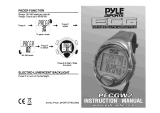Page is loading ...

Hydrophobic-Coated
Lens Finishing
Cat. No. Size/Shape Qty/roll
• 1707 18mm/oval 1000
• 1708 24mm/round 1000
3M™ LEAP™ LSE
Finish Blocking Pads
3M™ LEAP™ LSE
Finish Blocking Pads
For Hydrophobic-Coated Lenses
3M™LEAP™ LSE
Edging Pad s for
Hydrophobic-Coated Lenses
Finish Blocking Pads
For
Hydrophobic-Coated Lenses
3M™ LEAP™ III
Finish Blocking Pads
Standard line of 3M™ LEAP ™ III
high quality finish blocking pads for
non-hydrophobic coated lenses:
Standard Lens Finishing
3
3M Medical Specialties
3M Center Building 275-5W-05
St. Paul, MN 55144
3M and LEAP are trademarks of 3M.
Printed in U.S.A.
© 3M 2006 All Rights Reserved
70-2009-7477-5

The key to edging hydrophobic-coated lenses
is controlling the variables that lead to
slippage. Three main variables that have the
greatest influence on the edging process are:
Hydrophobic-Coating Consistency
Start with a stable blocking surface: Prior to
blocking, the lens should always be cleaned
with reagent grade IPA to remove hydrophobic
coating not tightly adhered to the AR stack.
This will ensure that the pad is adhered to a
stable surface.
Edging Equipment and Settings
High Pressure and slow cuts: The ram
pressure should be set on high and the cutting
rate on slow for both cribbing and final edging.
This is particularly important when edging
polycarbonate and high minus lenses.
• Polycrystalline cutting wheels create less
torque during edging than diamond-bonded
cutting wheels.
Edging pad / Block
Choose the right edging pad and block: 3M
LEAP LSE pads are designed to adhere to
hydrophobic coatings while maintaining axis
stability. Each side of the pad (front and back)
uses a different adhesive. Make sure the
printed (3M Logo) side of the pad is against
the lens.
• Block radius and lens should be closely
matched for optimum adhesion and wet-out.
• Blocks should be completely clean and dry
prior to pad application.
3M LEAP LSE edging pads are made
of a specially formulated adhesive
designed to improve the edging of
today’s new hydrophobic “non-stick”,
low surface energy coated lenses.
Designed for Hydrophobic Coatings
3M LEAP LSE pads are designed to adhere
to hydrophobic coatings, while maintaining
axis stability.
Dual Adhesive System
Each side (front and back) of the 3M LEAP
LSE pad uses a different adhesive.
• Non-printed side: Adhesive is formulated
for adhesion to the block.
• Printed (3M logo) side: Adhesive is
specially formulated for adhesion to
hydrophobic-coated lens surface.
Non-Printed Side → To Block
Printed (3M logo) Side → To Lens
3M™LEAP™ LSE
(Low Surface Energy)
1. Before blocking, clean the front surface of the
lens with reagent grade isopropyl alcohol. This
removes loosely bond hydrophobic coating not
tightly adhered to the AR (anti-reflective)
stack and ensures that the 3M LEAP LSE pad
attached to a stable surface.
2. Apply the 3M LEAP LSE pad to the block
before applying the pad to the lens. Ensure
that the non-printed side of the pad is to the
block.
3. Firmly apply the LEAP LSE pad to the lens.
Ensure that the printed side of the pad is to the
lens.
4. Make sure the 3M LEAP LSE pad completely
wets-out the surface of the lens.
Instructions for use
Preventing Slippage
/
